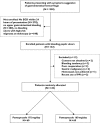A randomized controlled trial comparing two different dosages of infusional pantoprazole in peptic ulcer bleeding
- PMID: 20233195
- PMCID: PMC2829694
- DOI: 10.1111/j.1365-2125.2009.03575.x
A randomized controlled trial comparing two different dosages of infusional pantoprazole in peptic ulcer bleeding
Abstract
Aim: The optimal dosage of proton pump inhibitor in bleeding peptic ulcers remains controversial. The aim was to compare the clinical effectiveness of two doses of infusional pantoprazole in peptic ulcer bleeding.
Methods: Peptic ulcer patients (n= 120) with bleeding stigmata were enrolled after successful endoscopic therapy. After an initial bolus injection of 80 mg pantoprazole, patients were randomized to receive continuously infused pantoprazole at either 192 mg day(-1) or 40 mg every 6 h (i.e. 160 mg day(-1)) for 3 days. Clinical outcomes between the two groups within 14 days were compared, with 14-day recurrent bleeding regarded as the primary end-point.
Results: Both groups (n= 60 each) were well matched in demographic and clinical factors upon entry. Bleeding totally recurred in 11 (9.2%) patients, with six (10%) in the 192 mg day(-1) group and five (8.3%) in the 160 mg day(-1) group (relative risk of bleeding recurrence between two treatments 1.2; 95% CI 0.39, 3.72). All secondary outcomes between the two groups were similar, including the amount of blood transfusion (mean 1179 ml vs. 1203 ml, P > 0.1), hospital stay (mean 9.5 days vs. 9.9 days, P > 0.1), need for surgery (n= 1 vs. n= 0, P > 0.1), and mortality (n= 1 vs. n= 0, P > 0.1).
Conclusions: Following endoscopic haemostasis, infusional pantoprazole at either 192 mg day(-1) or 40 mg every 6 h appear similar.
Similar articles
-
Randomized controlled trial of high dose bolus versus continuous intravenous infusion pantoprazole as an adjunct therapy to therapeutic endoscopy in massive bleeding peptic ulcer.J Med Assoc Thai. 2012 Mar;95(3):349-57. J Med Assoc Thai. 2012. PMID: 22550833 Clinical Trial.
-
Randomized trial comparing pantoprazole infusion, bolus and no treatment on gastric pH and recurrent bleeding in peptic ulcers.ANZ J Surg. 2007 Aug;77(8):677-81. doi: 10.1111/j.1445-2197.2007.04185.x. ANZ J Surg. 2007. PMID: 17635283 Clinical Trial.
-
Intermittent versus continuous pantoprazole infusion in peptic ulcer bleeding: a prospective randomized study.Digestion. 2008;78(1):39-43. doi: 10.1159/000158227. Epub 2008 Sep 29. Digestion. 2008. PMID: 18824852 Clinical Trial.
-
Intravenous pantoprazole as an adjuvant therapy following successful endoscopic treatment for peptic ulcer bleeding.Can J Gastroenterol. 2009 Apr;23(4):287-99. doi: 10.1155/2009/191706. Can J Gastroenterol. 2009. PMID: 19373423 Free PMC article. Review.
-
Pantoprazole: a proton pump inhibitor with oral and intravenous formulations.Expert Rev Gastroenterol Hepatol. 2007 Dec;1(2):197-205. doi: 10.1586/17474124.1.2.197. Expert Rev Gastroenterol Hepatol. 2007. PMID: 19072410 Review.
Cited by
-
High-dose vs. Low-dose Proton Pump Inhibitors post-endoscopic hemostasis in patients with bleeding peptic ulcer. A meta-analysis and meta-regression analysis.Turk J Gastroenterol. 2018 Jan;29(1):22-31. doi: 10.5152/tjg.2018.17143. Turk J Gastroenterol. 2018. PMID: 29391304 Free PMC article.
-
Role of proton pump inhibitors in the management of peptic ulcer bleeding.World J Gastrointest Pharmacol Ther. 2010 Apr 6;1(2):51-3. doi: 10.4292/wjgpt.v1.i2.51. World J Gastrointest Pharmacol Ther. 2010. PMID: 21577296 Free PMC article.
-
Intermittent vs continuous proton pump inhibitor therapy for high-risk bleeding ulcers: a systematic review and meta-analysis.JAMA Intern Med. 2014 Nov;174(11):1755-62. doi: 10.1001/jamainternmed.2014.4056. JAMA Intern Med. 2014. PMID: 25201154 Free PMC article.
-
Proton pump inhibitor treatment initiated prior to endoscopic diagnosis in upper gastrointestinal bleeding.Cochrane Database Syst Rev. 2022 Jan 7;1(1):CD005415. doi: 10.1002/14651858.CD005415.pub4. Cochrane Database Syst Rev. 2022. PMID: 34995368 Free PMC article.
-
Comparison of different regimens of proton pump inhibitors for acute peptic ulcer bleeding.Cochrane Database Syst Rev. 2013 Jun 12;2013(6):CD007999. doi: 10.1002/14651858.CD007999.pub2. Cochrane Database Syst Rev. 2013. PMID: 23760821 Free PMC article.
References
-
- Lim CH, Vani D, Shah SG, Everett SM, Rembacken BJ. The outcome of suspected upper gastrointestinal bleeding with 24-hour access to upper gastrointestinal endoscopy: a prospective cohort study. Endoscopy. 2006;38:581–5. - PubMed
-
- van Leerdam ME, Vreeburg EM, Rauws EA, Geraedts AA, Tijssen JG, Reitsma JB, Tytgat GN. Acute upper GI bleeding: did anything change? Time trend analysis of incidence and outcome of acute upper GI bleeding between 1993/1994 and 2000. Am J Gastroenterol. 2003;98:1494–9. - PubMed
-
- Cook DJ, Guyatt GH, Salena BJ, Laine LA. Endoscopic therapy for acute non-variceal upper gastro-intestinal hemorrhage: a meta-analysis. Gastroenterology. 1992;102:139–48. - PubMed
-
- Adler DG, Leighton JA, Davila RE, Hirota WK, Jacobson BC, Qureshi WA, Rajan E, Zuckerman MJ, Fanelli RD, Hambrick RD, Baron T, Faigel DO. ASGE guideline: the role of endoscopy in acute non-variceal upper-GI hemorrhage. Gastrointest Endosc. 2004;60:497–504. - PubMed
-
- Leontiadis GI, Sharma VK, Howden CW. Proton pump inhibitor treatment for acute peptic ulcer bleeding. Cochrane Database Syst Rev. 2006;(1) CD002094. - PubMed
Publication types
MeSH terms
Substances
LinkOut - more resources
Full Text Sources


